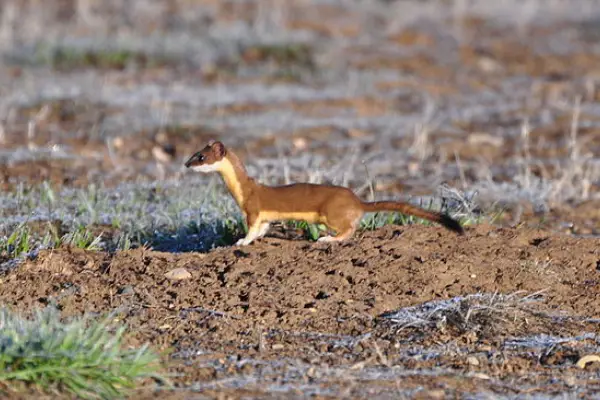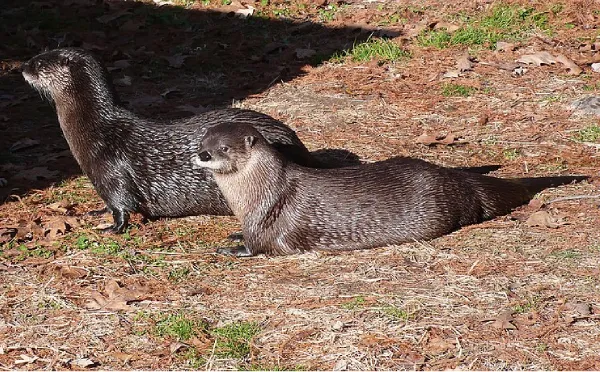According to the American Society of Mammalogists, there are 16 weasel species in the world – 10 of them have the word “weasel” in their name. Three of those live in North America.
The 2 species of weasels in Kentucky are the least weasel and the long-tailed weasel.
Primarily nocturnal, because of their secretive nature and miniature size, weasels might be hard to spot, even in the areas where their numbers are the highest.
Here are their photos, fun facts, and a short guide on how to recognize and differentiate them from other similar animals found in the wild.
Table of Contents
Weasel Species In KY
1. Long-tailed Weasel

Long-tailed weasels are the largest weasel species found in Kentucky and can be seen there statewide.
Also known as bridled weasels, masked ermines, or big stoats, they are the most widespread of any North American mustelid (carnivorous mammals like weasels, otters, fetters, minks, etc.).
Identify long-tailed weasels by their long and slender bodies, long necks, flattened heads, short legs, short and rounded ears, prominent whiskers, and black eyes. They also have dense brown fur that is white-yellow below – their brown tails have black tips and measure almost half the total body size.
During winter, in northern parts of the USA, long-tailed weasels can turn white, occasionally with yellow tints – their tails keep the black tips.

The track left behind by long-tailed weasels measures approximately 1 inch long and if they carry prey in their mouth, the footprints will also appear heavier. Despite having five toes, their tracks usually reveal only four distinct imprints.
However, when they walk in snow or mud, all five of their toes are visible. Additionally, you can identify the presence of a long-tailed weasel by the wavy indents their tails make in the snow.
- Scientific Name: Neogale frenata
- Length: 11-22 in
- Weight: 3-9 oz
- Tail Length: 3-6 in
Long-tailed weasels are common in different habitats, including woodlands, thickets, and brushy fencerows close to the water.
These large weasels are carnivores and will take what they can get – they feed on squirrels, chipmunks, rabbits, birds, reptiles, insects, fish, and especially small rodents like mice and voles.
They breed from July to August and have one litter per year with 1-12 young. The newborns are born naked, blind, 0.1 oz heavy (similar to a size of a hummingbird), and open their eyes at around 5 weeks of age.
Fun Fact: Long-tailed weasels can delay the implantation of the embryo after fertilization and can have a pregnancy that lasts between 205 and 337 days!
They are active during the day and the night – their black eyes glow bright emerald green when caught in a spotlight at night.
Predators of long-tailed weasels include coyotes, foxes, wolves, wildcats, cats, dogs, northern goshawks, and barred and great-horned owls.
Read more: List of weasel species seen in Florida and List of weasel species seen in Wisconsin
2. Least Weasel

Least weasels are the smallest weasel species and one of the smallest carnivores found in Kentucky.
They are extremely rare to see in the state with one study from 2016 discovering that out of 133 least weasel records from 7 southeastern states (Georgia, Kentucky, Maryland, North Carolina, Tennessee, Virginia, and West Virginia), only 26 were from Kentucky.
In Kentucky, least weasels have been granted state protection status of imperiled/vulnerable (S2/S3). This means that they are at a moderate to high risk of extirpation in the state.
Known under many names, including common weasels, little weasels, or simply weasels, these secretive and careful mammals can be very aggressive and defend their territories from any intruder.
Identify least weasels by their long and slender bodies, short legs, long necks, and flattened heads. Notice their short tails, rounded ears, visible whiskers, and black irises; least weasels have soft fur that is brown above and white below – their tails are also brown.
When winter comes, the fur turns pure white in animals living at high altitudes and those in the northern part of their range.

- Scientific Name: Mustela nivalis
- Length: 4.5-10 in
- Tail Length: 0.5-3.4 in
- Weight: 1-8.8 oz
Unlike the other weasel species found in KY, least weasels lack black tips on their tails, although they might possess a small number of black hairs.
They are most common in forests and woodlands with rocky slopes, marshes, brushy fields, and grasslands; least weasels tend to avoid dense forests.
These tiny animals are carnivores and will feed on small mammals like mice and voles, lizards, insects, birds, and bird eggs.
Fun Fact: Least weasels love to eat the heads and brains of their prey first and need to consume around half of their own body weight each day to survive.
Their small size allows them to search every hole, tunnel, or burrow in pursuit of food – they rely on their keen sense of sight, smell, and hearing when hunting.
Least weasels breed from spring to fall and have two or more litters per year with 1 to 7 young per litter. When born, young are hairless, toothless, deaf, blind, and pink – they get their teeth after 11 days and can hunt on their own by week 6.
Predators of least weasels include snakes, cats, foxes, owls, hawks, and other weasels.
Read More: List of Maine’s weasels and List of NY’s weasels
Weasels VS Minks VS River Otters
Kentucky is also home to other types of mustelids that resemble weasels: the American mink and the river otter. These creatures share a similar brown color and body shape.
One easy way to distinguish between them is by size. Among the four, the least weasel is the smallest; long-tailed weasels are bigger than them but smaller than minks.
Otters are the biggest and can grow more than twice the size of minks and three to four times the size of weasels!
Detecting the presence and distribution of weasels and minks in KY may pose a challenge due to their small size, swift movements, and knack for staying hidden.
Minks

Minks distinguish themselves from weasels with slightly larger sizes, a consistent dark brown hue, a streamlined body, a thick tail, small ears, and eyes. They measure 12 to 16 inches in body length without the tail and can weigh up to 4 pounds when mature.
Sometimes, minks exhibit a touch of white on their chin and throat.
- Scientific Name: Neogale vison
- Length: 12-18 in
- Weight: 1-4 lb
- Tail Length: 6-10 in
Read More: Examples of weasel species in Georgia
Otters

River otters can be identified by their short legs, webbed toes, and strong, flattened tails. They range in color from light to dark brown and have 5 toes and a horseshoe-shaped heel pad.
Otters can be sometimes confused with weasels, but they are far more sizable, weighing 10 to 30 pounds, measuring 26-31 inches long, and having blunted noses and tails that are thick at the base and then taper.
They can be seen around rivers, creeks, lakes, ponds, and swamps, although they are not as common in KY, being restricted to mostly westernmost parts of the state.
- Scientific Name: Lontra canadensis
- Length: 26-42 in
- Weight: 10-30 lb
- Tail Length: 12-20 in
Read More: List of weasel species seen in Massachusetts and List of weasel species seen in Ohio
Summary
Kentucky is home to 2 types of weasels, the least weasel and the long-tailed weasel. The long-tailed ones are more common while the least weasels are at risk of extirpation in the state due to a very restricted range and very few populations and occurrences.
Generally speaking, North America’s weasel populations may be in serious decline. According to a 2019 study, their numbers have been going down and long-tailed weasels may have disappeared from large parts of their range.
You might spot them beneath short decks, porches, or other low structures, which they can use to sneak into buildings. They track the smell of mice that they’re hunting and sometimes end up indoors. One way to know they’ve been around is by their long, twisty droppings.
Weasels love to hunt and eat different animals that might cause damage to crops – that’s why many farmers and homeowners welcome these animals.
The only thing they need to look out for is unsecured chickens and rabbits, weasels might catch them too!
Read More: Weasel species found in Michigan and Weasel species found in California